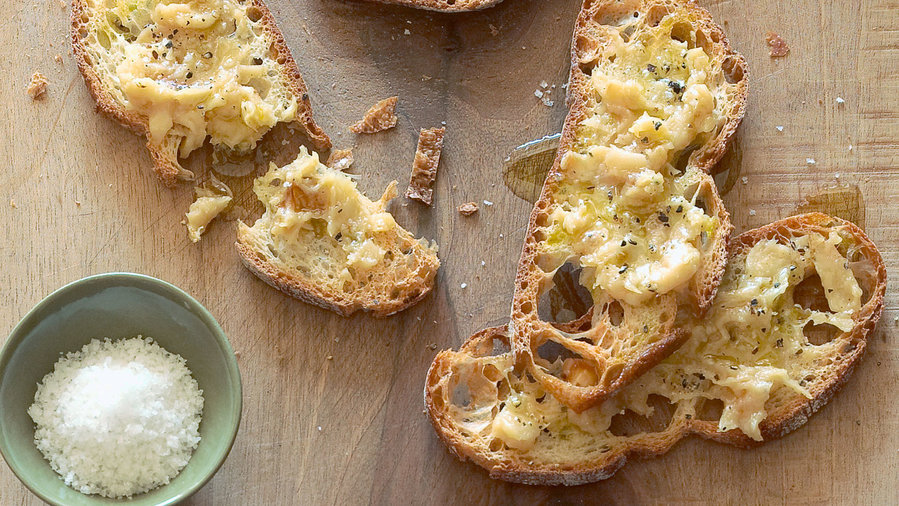Roasted Garlic Toasts with Olio Nuovo

Although you can use regular extra-virgin olive oil in this recipe, olio nuovo (new oil: see “Types of Olive Oil” below) works better. It’s pungent enough to stand up to the roasted garlic’s strong flavor.
How to Make It
Preheat oven to 400°. Cut tops off garlic heads (enough to expose cloves) and discard. Brush cut side of each garlic head with 1/2 tsp. extra-virgin olive oil, then sprinkle with salt and pepper.
Place each garlic head on a sheet of foil; enclose in foil. Bake 40 minutes. Remove foil packets, untwist tops, and drizzle each garlic head with another 1/2 tsp. extra-virgin olive oil. Return open garlic packets to oven and bake for 20 minutes.
Remove garlic from oven and increase heat to 450°. Squeeze garlic cloves from garlic heads (or pop cloves out with a knife) into a small bowl. Mash garlic with a fork.
Bake ciabatta slices on a baking sheet 6 to 8 minutes, or until well toasted, turning over once.
Spread roasted garlic on toasts. Drizzle with olio nuovo and sprinkle with salt and pepper. Serve immediately.
Types of Olive Oil
The USDA recently adopted these international standards for olive oil grades.
Extra-Virgin. The highest grade you can buy; the olives are pressed without using chemicals or adding heat, and they go through the press only once. To qualify as extra-virgin, the oil must also be free of specified taste "defects" and have less than 5 percent acidity.
Olio Nuovo. Italian for "new oil," this is an extra-virgin oil less than 3 months old. Intensely green, with a pungent, vibrant taste, it quickly loses its bite, so use it right away. (Most California-produced brands of olio nuovo appear in late fall, soon after the harvest, and often sell out quickly.)
Virgin. A lower grade than extra-virgin, lighter in flavor and higher in acidity.
Olive oil. Virgin oil blended, in varying ratios, with refined oil, which comes from olives that have already been pressed at least once; heat or chemicals may be used to extract more oil from the paste. Neutral in flavor and cheap.
Light. Refined oil with a small amount of virgin oil, if any; may also have other vegetable oils. "Light" doesn't mean lower in calories, just a lighter taste.
Infused/flavored. Oil in which fruit or herbs were steeped. Can also mean the olives were pressed with fruit or herbs, or that fruit or herb oils were added to the oil after pressing; both methods result in a more intense flavor than the steeping.
Note: Nutritional analysis is per toast.
Ingredients
Directions
Preheat oven to 400°. Cut tops off garlic heads (enough to expose cloves) and discard. Brush cut side of each garlic head with 1/2 tsp. extra-virgin olive oil, then sprinkle with salt and pepper.
Place each garlic head on a sheet of foil; enclose in foil. Bake 40 minutes. Remove foil packets, untwist tops, and drizzle each garlic head with another 1/2 tsp. extra-virgin olive oil. Return open garlic packets to oven and bake for 20 minutes.
Remove garlic from oven and increase heat to 450°. Squeeze garlic cloves from garlic heads (or pop cloves out with a knife) into a small bowl. Mash garlic with a fork.
Bake ciabatta slices on a baking sheet 6 to 8 minutes, or until well toasted, turning over once.
Spread roasted garlic on toasts. Drizzle with olio nuovo and sprinkle with salt and pepper. Serve immediately.
Types of Olive Oil
The USDA recently adopted these international standards for olive oil grades.
Extra-Virgin. The highest grade you can buy; the olives are pressed without using chemicals or adding heat, and they go through the press only once. To qualify as extra-virgin, the oil must also be free of specified taste "defects" and have less than 5 percent acidity.
Olio Nuovo. Italian for "new oil," this is an extra-virgin oil less than 3 months old. Intensely green, with a pungent, vibrant taste, it quickly loses its bite, so use it right away. (Most California-produced brands of olio nuovo appear in late fall, soon after the harvest, and often sell out quickly.)
Virgin. A lower grade than extra-virgin, lighter in flavor and higher in acidity.
Olive oil. Virgin oil blended, in varying ratios, with refined oil, which comes from olives that have already been pressed at least once; heat or chemicals may be used to extract more oil from the paste. Neutral in flavor and cheap.
Light. Refined oil with a small amount of virgin oil, if any; may also have other vegetable oils. "Light" doesn't mean lower in calories, just a lighter taste.
Infused/flavored. Oil in which fruit or herbs were steeped. Can also mean the olives were pressed with fruit or herbs, or that fruit or herb oils were added to the oil after pressing; both methods result in a more intense flavor than the steeping.
Note: Nutritional analysis is per toast.

